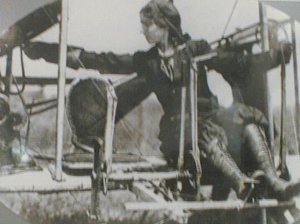Katherine Stinson
Today, meet the Stinson kids. The University of Houston's College of Engineering presents this series about the machines that make our civilization run, and the people whose ingenuity created them.
When I was a kid building model airplanes, one of my favorites was the Stinson Reliant, a fine private plane that seated four people. My friends and I had heard of the builder, Eddie Stinson, but we didn't know about his siblings, Katherine, Marjorie and Jack.
Katherine, born in 1891, was oldest. In 1910, seven years after the Wright Brothers flew, she wanted to study music in Europe. But that would cost a thousand dollars she didn't have. Then she read about the new stunt fliers. The best barnstormers could earn a thousand dollars in a good day -- as long as they stayed alive.
By 1912 she'd located flying pioneer, Max Lillie. Would he teach her to fly? Lillie looked at Katherine's five-foot, hundred-pound frame, and said, "Not a chance!" She finally persuaded him to take her for a ride. When he did, he realized she was utterly calm and self-possessed. She may've been small but she was a natural.
Her mother supported her ambition, but Katherine had to wear her father down. He finally paid half her flying-school tuition; she sold her piano to get the rest. She thus became the fourth American woman with a pilot's license. Next, she claimed to be only 16 (instead of 21), she billed herself as The Flying Schoolgirl, and she took up exhibition flying. She and her mother formed the Stinson Aviation Company. Katherine was the first woman airmail pilot and first to fly a loop. She flew exhibitions in Japan and China.
Then her younger sister Marjorie qualified as the ninth American woman to earn a pilot's license. After her brother Eddie got his license in 1915, the family moved to San Antonio and set up a flying school. Eddie worked as a mechanic. Jack also learned to fly and formed a school of his own. But when we joined WW-II, the military banned civilian flying. The schools had to be liquidated.
Katherine had already tried to enlist as a pilot. She eventually went to France as an ambulance driver and as an occasional flier for the Red Cross. Before the school closed, Marjorie had trained Canadian pilots, who called her The Flying Schoolmarm. Then she went to work for the Navy doing aeronautical drafting.
After the war, Katherine went back to flying airmail, but she came down with tuberculosis in 1920. After a long recovery, she married a former WW-I pilot. She did a little more flying but, in 1930, they both decided to quit piloting airplanes. She did drafting for the Army, then took up architecture. She won prizes for her designs and she lived to the age of 86.
Eddie Stinson, who designed private planes between bouts with alcoholism, is the one my generation remembers. But Katherine Stinson, daring and methodical Katherine, was the driving engine behind it all. It all took place because she sold her piano in a Byzantine plan to study music in Europe! Well, she got to Europe all right. And she did shape a rich life in the process.
I'm John Lienhard, at the University of Houston, where we're interested in the way inventive minds work.
(Theme music)
Rogers, M. B., Smith, S. A., Scott, J. D., and Shaw, C., We can Fly: Stories of Katherine Stinson and Other Gutsy Texas Women. Austin, TX: Ellen C. Temple, Publisher, 1983. (This is a book intended for young people.)
Wedemeyer, D., Katherine Stinson Otero, 86, dies: Pioneer Aviator and Stunt Flier. New York Times, July 11, 1977, pg. 28.
Lomax, J., Women of the Air. New York: Ivy Books, 1987, pp. 34-39.
For more information on Katherine Stinson, see her Wikipedia page.

An early photo of Katherine Stinson at the controls